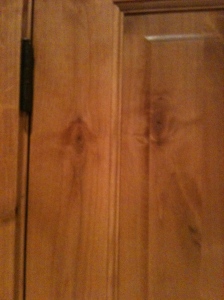
Lighter “toned” Alder Wood

Dark Alder – Method 1
Alder is the most prevelant wood species in our mountain community. The dark knots and variable wood grain lends for a rustic outdoor look. There is more than one way to stain and finish semi-hard woods like the Alder species. It depends on the depth and tone of the stain color. Here are the two methods we use on a regular basis and a few different clear finishes that can be applied.
Our first method is used on more of a regular basis. Always work up stain samples on scrap wood, it will save huge headaches later.
1. Sand the wood with the grain using 220 sandpaper. Sand by hand in order not to get those swirls from a palm sander.
2. Stain – One coat with a wiping stain and remove within 5 minutes. The longer the stain sits the darker the stain penetrates. A penetrating stain can also be applied in which will increase this effect. We prefer wiping stain due to the control and shorter open time and ease of wiping.
3. Dry 24 hours.
4. Apply a waterborn sealer – up to 3 very light coats (spray – small tip – low pressure). Allow to dry and sand with 220 between coats.
5. Apply waterborne lacquer or polycrylic top coats (2-3). Light sand between coats.
6. Allow to dry. Fill nail holes with custom matched wood putty and wipe smooth. Stain pens and artist brushes can be used to seal the holes and help match the color.
7. Re-set and install hardware.
Our second method is used on very specific stain colors, which can be a bear to match. Lighter stain colors turn out the best. Use a good custom matcher at your paint store. Be sure the matcher at the paint store is apt at matching stains. Be sure he uses multiple toner coats, conditioner and the right top coat finish so you know the end result.
This method can be tedious and the results are apparent. This method is also used on new furniture and very nice hard-wood pieces.
1. Sand the wood with the grain using 220 sandpaper. Sand by hand in order not to get those swirls from a palm sander.
2. Condition wood. Follow manufacturers instructions. Be sure to use an ample amount and certain areas may need additional coats. Apply first stain coat before conditioner dries.
3. Stain Coat 1 (toner) – One coat with a wiping stain and remove within 5 minutes. The longer the stain sits the darker the stain penetrates. A penetrating stain can also be applied in which will increase this effect. We prefer wiping stain due to the control and shorter open time and ease of wiping. This stain coat is often a lighter stain with more of a primary tone (red, green, ect.). Allow to dry.
4. Very light sand at dark, blotchy areas. This is a delicate step. Too much and you are in trouble. We use worn out 220 blocks or 400 very fine blocks.
5. Second stain coat (second toner color). This stain will be the right color to allow subtle colors from the previous stain to show through, leaving a more briliant and complex wood grain. Follow directions as applying forst coat.
3. Dry 24 hours.
4. Apply 3 coats of solvent based sanding sealer (HVLP or air-assisted airless). Good sand after final coat (220).
5. Apply 3 coats of lacquer (HVLP or air-assisted airless).
6. Allow to dry. Fill nail holes with custom matched wood putty and wipe smooth. Stain pens and artist brushes can be used to seal the holes and help match the color.
7. Re-set and install hardware.


